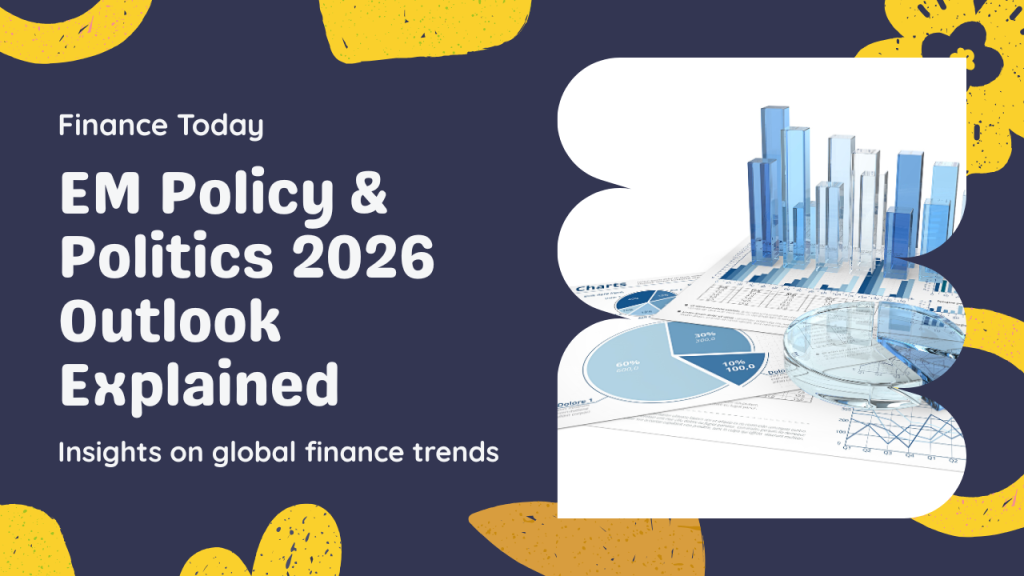
Setting the Stage: Policy & Politics in 2026
Emerging Markets (EM) in 2026 will be shaped not only by macroeconomic trends but also by political transitions, elections, and policy credibility. Investors must pay close attention to fiscal discipline, monetary policy autonomy, and geopolitical alignments, which are increasingly decisive for capital flows.
In 2026, more than a dozen EM countries will undergo major elections, while structural policy shifts — from carbon neutrality to digital regulation — will continue to reshape the investment environment.
Global Policy Landscape
U.S. & Fed
- Expected easing cycle reduces pressure on EM monetary policy.
- EM central banks gain more room for independent rate-setting.
Europe & Trade Policy
- EU carbon border adjustment mechanisms (CBAM) continue, impacting EM exporters.
- Trade policy fragmentation remains a challenge for global supply chains.
China
- Policy support for green energy and technology remains strong.
- State-led economic management persists, impacting EM trade partners.
Key Political Events in 2026
India General Elections
- BJP-led government expected to maintain majority.
- Continuity in reform agenda and infrastructure push.
Mexico Presidential Elections
- Policy continuity likely, but populist rhetoric on energy and inequality remains a risk.
South Africa Elections
- Governance and power sector reforms are key issues.
- Investor sentiment hinges on credible fiscal policies.
Turkey Local Elections
- Critical test for opposition strength.
- Policy normalization at risk if political instability rises.
Fiscal & Monetary Policy Trends
- Fiscal Discipline: Countries like Brazil and South Africa under pressure to maintain spending caps.
- Monetary Credibility: RBI (India), Banxico (Mexico), and BOK (Korea) seen as anchors of stability.
- Debt Sustainability: Frontier markets (Nigeria, Kenya, Egypt) face higher default risks without IMF support.
Interim Insights (Mid-2026 View)
- EM policy divergence is widening: credible central banks and reform-driven governments are rewarded with lower borrowing costs.
- Elections in India and Mexico are potential turning points, but policy continuity is expected.
- Geopolitics (U.S.–China rivalry, Middle East instability) remains the wildcard for EM investors.
Risk Scenarios in 2026
- Election Surprises
- Populist victories in Latin America or Africa could derail fiscal consolidation.
- Geopolitical Escalations
- South China Sea tensions, Middle East instability, or Russia–Ukraine conflict escalation may disrupt global supply chains.
- Policy Missteps
- Currency controls (Argentina, Nigeria) or excessive fiscal spending (Brazil, Turkey) could spark capital flight.
- Climate & ESG Regulations
- Rapid carbon taxation or stricter ESG rules could pressure commodity exporters.
Investment Strategy Recommendations
- Favor Credible Policymakers
- India, Mexico, Korea, and Chile benefit from stable institutions.
- Watch High-Risk Sovereigns
- Turkey, Argentina, Nigeria remain vulnerable to political shocks.
- Geopolitical Hedges
- Allocate to gold, GCC assets, and USD/JPY as safe havens.
- Thematic Plays
- ESG-linked bonds and green infrastructure in reform-driven EMs.
Portfolio Construction Ideas
- Core Allocation
- 60% EMs with strong policy credibility (India, Mexico, Korea, Chile).
- 25% tactical commodity-linked EMs (Brazil, Indonesia, South Africa).
- 15% hedges via gold and GCC sovereign bonds.
- Event-Driven Allocation
- Use elections as tactical entry points: pre-election volatility may create attractive pricing.
Key Takeaways: Policy & Politics in 2026
2026 will be the year where policy credibility defines winners and losers in EM. Countries that deliver on fiscal discipline and structural reforms will attract long-term capital, while those trapped in populism and policy inconsistency will struggle with capital flight.
Geopolitics will continue to shape the EM narrative, but investors can mitigate risks with selective exposures and hedges.
Leave a Reply